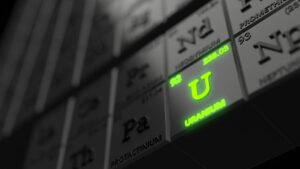Resources Top 5: Which ASX tungsten and uranium stocks reached ridiculous highs today?

Pic: Schroptschop / E+ via Getty Images
- Tungsten companies King Island Scheelite and Tungsten Mining were in-demand stocks
- Helium and hydrogen explorer Global Oil and Gas rose on project exploration approvals
- Uranium explorer Boss Energy ticks higher as it starts talks with potential lenders
Here’s your top ASX small cap resources winners in morning trade Thursday, February 4.
King Island Scheelite (ASX:KIS)
Shares in the tungsten company were in high demand in Thursday trade after announcing this week a $10m loan from the Tasmanian government.
The 10-year loan is to support the development of its high-grade Dolphin project on King Island off Tasmania which contains high-grade amounts of the tungsten mineral scheelite.
Tungsten is a key input for ‘national security’ industries such as defence and also in the passenger transport, mining and construction sectors.
The US is currently without any domestic tungsten production, and prices for the metal have been creeping higher on tight supply and increased end-user enquiries, said reports.
The Dolphin mine operated on King Island up until 1992, when uneconomic tungsten prices forced its closure, and King Island Scheelite plan to bring it back into production.
A revised feasibility study for the Dolphin project shows a net present value in today’s dollars of $241m, and the company has signed an off-take agreement with trader Noble Group.
The offtake is for 1,500 tonnes per year of Dolphin tungsten concentrate and with another supply deal represents about 70 per cent of the proposed mine’s annual supply.
The tungsten concentrate will be delivered to Noble Group subsidiary, Kalon Resources, a supply chain manager and physical commodity trader for base metals including tin, tungsten, tantalum and niobium, and chrome and manganese.
Sales revenue under the Kalon offtake agreement is about $23m per year.
Investors were seeing bright prospects in the tungsten metal sector Thursday, with the share price of another tungsten company Tungsten Mining taking off in early trade.
The company announced last week the completion of a pre-feasibility study underwriting its proposed 6 million tonnes per year mine at its Mt Mulgine project in WA.
“Tungsten is recognised as a critical mineral by the US, the European Commission, Japan, China and Australia, a key driver of industrialisation with high economic importance,” chief executive, Craig Ferrier, said.
China is the world’s largest supplier of tungsten, producing around 85 per cent of the global market’s 80,000-tonne annual supply, and Russia is the second largest at 3,500 tonnes.
Several large mines in China and Russia are reaching the end of their working lives and will need to be replaced, and a Spanish mine closed in 2019, said metals consultancy Roskill.
Tungsten metal is currently trading at around $US240.50 per metric tonne unit on a free-on-board price basis at Chinese ports, according to price reporting agency Argus Media.
Spot market prices for the metal reached a recent peak of $US350 per MTU in mid-2018.
The energy company rose steadily Thursday on announcing exploration approval for its hydrogen and helium projects in the Northern Territory’s Georgina Basin.
Australia produces only 3 per cent of the world’s supply, mostly from a gas field off Darwin which is in decline, and the high value specialty gas is considered a strategic element.
Helium has application in a wide range of industries including fibre optics, space equipment and rockets, cooling and high-level science and is a byproduct of hydrocarbon gas.
The company has been waiting to begin a geochemical survey of its project site in April at the end of the Northern Territory’s wet season.
Global Oil and Gas said it believed the project’s geology suggests it should focus on rare earth gases of helium and hydrogen which could be transformative for the company.
Shares in the uranium exploration company continued to show momentum from its announcement this week on seeking finance for its Honeymoon project in South Australia.
Boss Energy is set on becoming Australia’s newest uranium producer and has started talks with a number of global lenders to secure funding for the project.
The capex funding requirement for Honeymoon is around $US63.2m and a feasibility study for the project is on track for delivery in Q2.
“There is a widespread expectation that uranium prices will rise in the near term as the supply deficit grows,” managing director, Duncan Craib, said.
Uranium spot prices are trading at just below $US30 per pound despite a round of mine closures, some temporary due to the COVID-19 pandemic, and some longer term like Rio Tinto’s Ranger mine in the Northern Territory.
Boss Energy’s Honeymoon project has a proposed nameplate capacity of 2.45 million pounds per year for uranium oxide.
Rare earths exploration company RareX traded higher as its entered into a memorandum of understanding with Chinese rare earths producer Shenghe Resources.
The deal establishes a framework for a jointly-owned rare earths trading company sourcing rare earths concentrates from outside China in the global market.
The proposed ownership structure of the Rare Earths Trading Company is 51 per cent for Shenghe Resources and 49 per cent for RareX.
“This is an exciting development for RareX and our shareholders which opens up a number of significant growth pathways,” managing director, Jeremy Robinson, said.
There is also the potential under the deal for Shenghe Resources to invest in RareX’s flagship Cummins Range rare earths project in WA’s Kimberley region.
Shenghe Resources is listed on the Shanghai Stock Exchange and has a market value of $US4.6bn, and is a leading producer of rare earths, zirconium and titanium.
At Stockhead, we tell it like it is. While RareX is a Stockhead advertiser, it did not sponsor this article.
Related Topics

UNLOCK INSIGHTS
Discover the untold stories of emerging ASX stocks.
Daily news and expert analysis, it's free to subscribe.
By proceeding, you confirm you understand that we handle personal information in accordance with our Privacy Policy.








